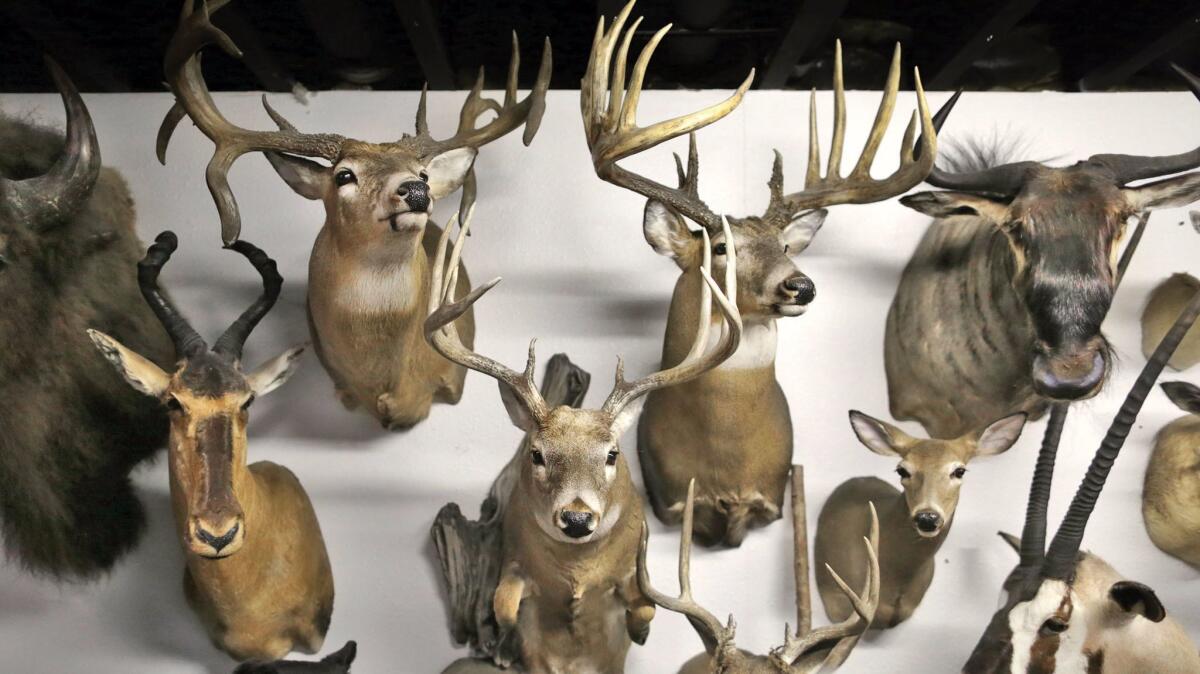Sex in a pan, an elk on the car: food and the stories we tell

- Share via
In September, in Nebraska, my dog and I saw an elk head on the roof of a white Suburban, the spreading antlers glistening with dew, the massive skull wrapped in blue plastic, in a service area off Interstate 80. Then three slight young men wearing traditional Amish clothing stepped from the back seat and lit cigarettes, smoke reaching up into the antlers. A massive young white guy, tall and soft in a white sweatsuit, got out from the driver seat and stood at a distance with a can of Red Bull, speaking impassively on his phone.
The Amish men told me they’d killed the elk in the mountains of New Mexico, the night before, the last of nine days of hunting. They were headed home to their family farm in Ohio. Their father would be happy to have 1,500 pounds of meat to feed people all winter.
On the road east, I imagined the story — did they hire an “English” guy to drive and buy gas and do the things Amish are not allowed to do? Did they smoke only while hunting? Did they shoot the elk — or kill it with bow and arrow? Suddenly I saw deer meat from “Venison” in J. Ryan Stradal’s novel “Kitchens of the Great Midwest.” A young man in Minnesota goes hunting — kills a doe not knowing her fawn is nearby — and when he brings the meat home, his mother has died of her terminal illness while he was there in the woods. Later he gives away the entire deer — frozen plastic-wrapped flesh.
Since I was 5, I’ve seen dual versions even while something occurs before me: The real sight, and the imagined fictional scene. Perhaps this is the strange way writers’ brains work — perhaps it is only me. The impulse to superimpose real life to fiction has only intensified now. At 12, I read Toni Morrison’s “Sula” for the first time. Last month, when my 25-year-old daughter prepared green beans for Thanksgiving, her long, brown fingers moved among the long, green pods. I saw: “What with the sound of the cracking and snapping and her swift-fingered movements, she seemed to be playing a complicated instrument.” Those beans, in Lorain, Ohio, were Kentucky Wonders.
The dog and I passed through Lorain on a round-trip journey of more than 7,000 miles, from Southern California to Prince Edward Island, Canada. It’s about as far as you can go, from edge to edge on this continent, and then a little farther over the ocean. Of course there are echoes of “Anne of Green Gables.” (Thankfully no drowned mice in sauce, or cake made with liniment.) There are bars.
The first time I went to a luncheon at St. Margaret of Scotland Church, on the eastern wing of Prince Edward Island, laid out on the long tables by women of all ages were rectangles of sweetness with what seemed to me exotic names: Matrimonial bars (dates, butter, brown sugar, oats). Nanaimo bars (named after the city in British Columbia, wafer crust, sweet custard and melted chocolate topping). Seven-layer bars (the layers depended on the baker). There were probably 100 people in the church hall – seventh-generation islanders whose ancestors built the first incarnation of this church in 1803 after fleeing religious persecution in Scotland. The women recognized the bars, by sight and taste; they said, “Oh, Bertha brought those,” and “Those are Anne’s – I’ll have to take two.”
Later, I went to night lunch at a home even farther east. Night lunch is after supper. Arrival at 7, visiting for two hours, and at 9 p.m. sitting down to homemade biscuits, ham, cheese, butter, homemade jellies and three kinds of bars. Steeped tea blacker than coffee — several cups. We talked until midnight. Then everyone would get up before dawn and start the day — contractors and potato farmers and lobster fishermen.
For another supper, a neighbor laughed and said she’d bring Sex in a Pan. (Yes — that can be sliced into a bar. Canadian favorite. Look it up.) Another Stradal chapter, “Bars,” is an intense competition for the very soul of a woman through the judgment of rectangular dessert. I had a copy of the novel in my island kitchen, brought to give to a friend whose husband had just died. He was a locally famous home cook, who taught me how to prepare lobster fresh from the ocean. For him, I always made the closest thing I have to bars: pure shortbread.
Days before the November election, on the long drive back to California, I thought constantly, of course, about food. Not just for survival — truck stops where I always ate eggs, rest areas where I ate cheese and summer sausage, McDonald’s off toll roads where I saw cross-sections of all humanity — not a single person talked to me of politics. Only football — high school and college and pro — and food. Gourmet popcorn, favorite coffees, what they wished they were eating at their family homes.
In the windshield, I saw fictional scenes. In Massachusetts, just ahead of snow flurries, inexplicably I saw the hot baked potato concealed in Beth’s apron, brought to the German family whose baby gave her the scarlet fever which eventually led to her death, in “Little Women.” In Iowa, the final harvest of corn and the drying stubble gave me Jane Smiley’s “A Thousand Acres.” In Wyoming, my dog eyed buffalo, and I envisioned the bison hunted by young men in James Welch’s “Fools Crow.” When I pulled onto my own street, my neighbors were making carne asada; I saw my brother working in an orange grove, and the Chihuahua-born men who taught him how to grill meat; for “Highwire Moon,” I wrote about migrant women cooking in a grove camp.
Two days earlier, I’d pulled in on a late, cold night to Peru, Illinois. Near a mall was a small Mexican restaurant. I’d missed with visceral craving the food of my home. Inside, all the customers were white, wearing coaching and football and cheer uniforms, parents questioning the owner about spiciness of dishes. At the to-go window, I saw that only five men ran the place. No waitresses. The owner looked up from his pad; I said I was driving home to California, and spoke some Spanish. He smiled, said he was from Guanajuato. “I just paid $105 for a crate of avocados and I had to drive 50 miles to get them! They were from Mexico.”
We both laughed. I told him of the tree at my fence that bears three crops a year of Fuerte avocados, and he sighed deeply. His chicken enchiladas, which I ate in the car, made me sigh deeply. This week, as our nation warily parses the future, I keep picturing a real scene – chilled fair-skinned Illini, named for Native Americans, being handed nachos by a man from Guanajuato who dreamed of an avocado tree in his own backyard.
Straight’s memoir of California, “A Sunday Kind of Love,” will be published in 2017. At 7 p.m. on Tuesday, Straight and J. Ryan Stradal will be in conversation at The Last Bookstore for the paperback release of “Kitchens of the Great Midwest.” Straight notes, “I thought there should be bars. So bring your bars and your stories. He will judge his favorites, and I will bring shortbread.”
More to Read
Sign up for our Book Club newsletter
Get the latest news, events and more from the Los Angeles Times Book Club, and help us get L.A. reading and talking.
You may occasionally receive promotional content from the Los Angeles Times.









